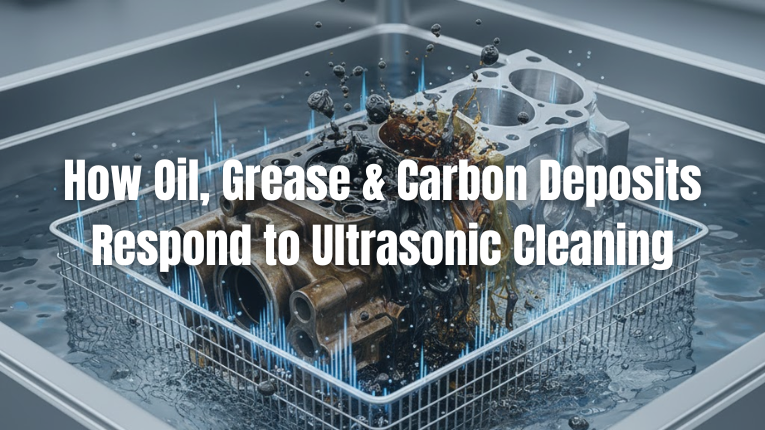24 Nov How Oil, Grease & Carbon Deposits Respond to Ultrasonic Cleaning
A Complete Guide for Modern Industries
Industrial components often accumulate stubborn contaminants like oil, grease, and carbon deposits that conventional cleaning methods fail to remove. These residues not only degrade equipment efficiency but also cause defects, reduce heat transfer efficiency, and increase maintenance downtime.
At Ralsonics, we specialize in advanced ultrasonic cleaning systems designed to tackle these challenging contaminants across industries such as automotive, aerospace, medical devices, manufacturing, electronics, and heavy engineering.
This blog explains exactly how oil, grease, and carbon respond to ultrasonic cleaning and why Ralsonics’ ultrasonic technology delivers unmatched results.
Understanding Ultrasonic Cleaning
Ultrasonic cleaning uses high-frequency sound waves (20 kHz to 200 kHz) generated by transducers integrated into a stainless-steel tank. These sound waves form microscopic cavitation bubbles in the cleaning liquid.
When these bubbles collapse:
- They create micro-jets and high-energy shockwaves
- They dislodge contaminants from the surface
- They penetrate inside blind holes, threads, and micro-channels
- They clean uniformly without damaging the component
This makes ultrasonic cleaning the most effective technique for stubborn industrial contaminants.
1. How Oil Responds to Ultrasonic Cleaning
Oil residues adhere tightly to surfaces due to their hydrophobic nature. Ultrasonic cleaning breaks these bonds using:
a) Mechanical agitation
Cavitation micro-jets break the oil layer into micro-droplets.
b) Emulsification
Detergents mix with the oil droplets, suspending them in solution.
c) Penetration into crevices
Ultrasonics reach fine geometries that brushing or spraying cannot.
Best parameters for oil removal
- Frequency: 25–40 kHz
- Temperature: 45–60°C
- Detergent: Mild alkaline or neutral cleaners
Common Ralsonics applications
- Machined parts with cutting oil
- Automotive engine components
- Hydraulic system parts
- Electronics & PCB flux removal
2. How Grease Responds to Ultrasonic Cleaning
Grease is a combination of base oil + thickener + performance additives, making it more viscous and adhesive than oil.
How cavitation handles grease
- Cavitation waves soften and break down grease structure
- Heat reduces viscosity, making it easier to detach
- Detergents dissolve the lifted grease film
Optimal cleaning parameters
- Frequency: 25 kHz (heavy grease), 40 kHz (general grease)
- Temperature: 50–70°C
- Detergent: Strong alkaline cleaners
Industries using Ralsonics for grease cleaning
- Automotive garages, service centers
- Power tools and industrial robots
- Food processing machinery
- Heavy mechanical assemblies
3. How Carbon Deposits Respond to Ultrasonic Cleaning
Carbon fouling is formed by thermal degradation, combustion residues, and oil oxidation. It is the toughest contaminant to remove.
Why carbon is challenging
- Hard, brittle, strongly bonded
- Forms deep inside cavities
- Resistant to manual scrubbing
Ultrasonic cleaning advantages
- High-intensity cavitation fractures the carbon layer
- Shockwaves penetrate porous carbon
- Heated alkaline chemistry weakens the bond
- Reaches narrow passages and fuel injector micro-holes
Ideal settings for carbon removal
- Frequency: 25 kHz for aggressive cavitation
- Chemistry: Alkaline detergents with surfactants
- Temperature: 50–70°C
Industries that benefit
- Automotive: injectors, pistons, DPFs
- Aerospace turbine components
- Engines and combustion systems
- 3D printed metal parts post-processing
Why Ultrasonics Outperform Traditional Cleaning
- Removes contamination from complex geometries
- No abrasion, safe for precision components
- Dramatically reduces cleaning time
- Uniform cleaning across all surfaces
- Reduces chemical usage and enhances sustainability
- Ideal for batch cleaning in high-volume industry
Ralsonics’ industrial ultrasonic cleaners are engineered to deliver maximum cavitation intensity, consistent performance, and low operating costs.
Applications Across Industries
Ralsonics ultrasonic systems efficiently remove oil, grease, and carbon from:
- Engine blocks, pistons, valves, injectors
- Aerospace turbine blades and heat exchangers
- Hydraulic equipment and transmission parts
- Food industry mechanical components
- Medical equipment and surgical tools
- Electronics assemblies and heat sinks
- Precision machined parts
- Die cast components
Best Practices for Maximizing Ultrasonic Cleaning Performance
- Use the right frequency
- Low frequencies (20–28 kHz): heavy carbon and grease
- Mid frequencies (35–45 kHz): oil and general cleaning
- High frequencies (68–130 kHz): precision parts
- Maintain proper temperature
Warm solutions enhance chemical and cavitation efficiency.
- Choose the right chemistry
Detergents accelerate emulsification and soil breakdown.
- Load components correctly
Parts should not touch each other or the tank bottom.
- Keep the solution filtered
Prevents re-deposition of contaminants.
Conclusion
Ultrasonic cleaning is one of the most powerful and reliable methods for removing oil, grease, and carbon deposits from industrial components. The cavitation effect, combined with the right chemistry and temperature, delivers unparalleled cleaning performance.
At Ralsonics, our ultrasonic systems are engineered to handle the toughest industrial contaminants with unmatched efficiency, making them essential for modern manufacturing, automotive, aerospace, medical, and precision engineering applications.
If you need customized cleaning solutions or want to automate your cleaning line, Ralsonics can design systems tailored to your process requirements.


No Comments